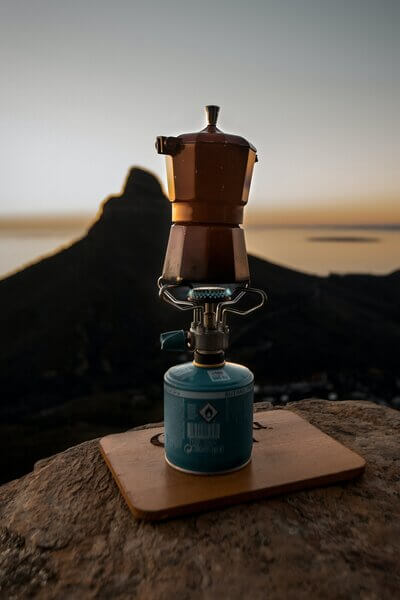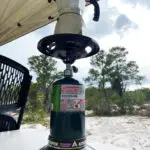Camping propane tanks are very convenient to use and easy to store. The thing with them is that you need to know how to store them. If you know the basics, you will have no problem at all!
During any camping trip I take, I tend to use propane tanks to power my camping stove. Using the stove, I can make any meal I want to. Then, I either dispose of the empty propane tank in a designated place or take the tank back home if there is some gas left in it.
Natural gas is not something that you should play with. If you are planning to keep some at your home, I recommend that you learn exactly how you should store them. I will tell you all about the storage of these tanks in today’s guide, so stay tuned for the details!
More...

Table of Contents
How Do You Store Camping Propane Tanks?
First things first – let’s talk about what a camping propane tank is. This is a tank of camping propane gas almost identical to regular propane. The tank itself separates the first and second types of propane. With the camping propane, the tank is always smaller.
But what is smaller is not necessarily less important and even less dangerous. Storing the camping propane tanks is as important as storing large propane tanks. If you do not store the tanks well, you will have a big problem with your hands. This is because the tanks can leak and even lead to a huge explosion.
If there is one thing you can take from this, it should be that camping propane tanks are no joke. If you plan to have some on your property, you should store them correctly. Here is how you can do that:
Step 1 - Position
The first and most important thing is that you store the propane tanks upright – no side, no upside-down position is allowed!
Another thing to remember about the position is that the tanks should never be close to any electrical tools or other flammable materials. These things can cause sparks or even explosions if they are close to the tanks. So, keep them as far away as possible.
Step 2 - Temperature
The second thing is that you keep the thanks away from direct sunlight. It would be best to put the tanks in the shade and keep it there at all times. The area's temperature should be below –40 degrees Celsius in winter to 49 degrees Celsius in summer.
Step 3 - Surface
Another important note is that you keep the tanks on a flat surface. It can be any sturdy surface, but it would be best if it is a bit removed from the floor. The extra space below the surface will be great for ventilation, which these tanks need.
Step 4 – Ventilation
As mentioned in the previous step, ventilation is very important. You should leave all gas tanks in a well-ventilated area. I must say that the area should never be in your actual home – a removed garage or shed would be much better. That way, even if there happens to be a leak, you will not be close to it.
Where Do You Store Propane Tanks When Not in Use?
Many campers make errors when calculating the amount of gas they need for a trip. Either that or buying in bulk leaves them with many propane tanks they need to store somewhere and somehow.
I have been in both situations, and I have also had to deal with tanks that were full and half-empty. After some time, I realized that the tanks must be at full capacity if you want to avoid having problems with them. The half-empty ones might rust on the inside and become compromised. That will make them impossible to use again.
This is why I recommend storing only full tanks. You should try to use the other ones or dispose of them as soon as possible. Keep the full ones and store them according to the guidelines I mentioned in the previous section. But if you want to know more storage tips for different storage locations, you can check out the following sections:
Where to Store Propane Tanks at Home?
You must never store propane tanks in your existing home. I know that sometimes you might want to keep things close and not have to walk around to get them. Trust me on this one – you might save yourself a lot of trouble by keeping the tanks away from the house.
If you have a separate garage, shed, or workplace - use it for storage. Any sort will be a good place to store the propane tanks. Make sure they are flat a few inches above the ground. The place must be well ventilated and shady – no direct sunlight is allowed!
Also, make sure there are no electrical tools or anything flammable around. These are all important notes. Another thing to consider is getting a separate cabinet to keep the tanks in. If you do this, make sure that the cabinet can fit the tank in an upright position.
Keeping the tank upright is also very important. Do not think you can fit the small propane tanks in small places around your garage. These tanks need and deserve their space, so make sure you give it to them. Otherwise, they will cause you a lot of trouble.
Where to Store Propane Tank During Summer?
What is interesting about small propane tanks and all propane tanks, in general, is that there is a specific temperature at which you should keep them. For example, propane is suitable for use and storage in all temperatures. But you must keep it between temperatures of –40 degrees Celsius in winter to 49 degrees Celsius in summer.
This means that you can keep the tanks outside during summer, but the area must be in deep shade, and the temperature must be below 49 degrees Celsius. If the weather becomes any warmer, you must move the propane tank inside.
The best storage practice for keeping propane tanks outside is to have them in the shade, on a flat surface, or on the ground. They should not be close to your house and must remain upright at all times. Always remember that they should not be in your car either.
The same goes for keeping propane tanks inside during summer. You must have a well-ventilated area and safe temperature to keep the propane tanks safe.
Before storing your propane, ensure the valve is in the proper position. If there are leaks, that would not be good. So, make sure that you double-check that before putting the tanks away for a while. If you do all as mentioned here, you will be perfectly safe!
How to Store Propane Tanks Outside?
I have already mentioned the best storage practices for storing small propane tanks outside during summer. Let’s now talk about storing such tanks outside during winter.
Unlike butane, propane can withstand cold temperatures. You will not need to do anything besides the things mentioned thus far. The tank must be in an upright position, on a sturdy surface, in a shaded area. The temperature must not fall below -40 degrees Celsius.
Another thing to remember is that you can cover the tanks during the winter. This is a possibility, but it is not something you have to do. Following the other guidelines is more important than following this recommendation.
Should you store the propane tanks correctly, they will have a long shelf life. The quality camping propane tanks are known to last upwards of 10 years. So, even buying bulk, you can use the tanks for future trips.
But please ensure you are doing everything right when storing propane tanks. If you are unsure about the state of a tank, it is better to get rid of it than keep it around your home. I would hate for you to deal with a gas leak or anything similar.
Wrap-Up
You need to know everything about camping propane tanks and how to store them. Remember all the notes I made throughout the guide, as they are crucial to your and your family’s safety. Never keep the propane tanks in your house – only in areas close to you!
What is your experience with such propane tanks? Have you ever used any, and did you find them easy to use? What type of camping propane tank do you recommend to fellow campers? Let me know your thoughts on the topic in the comments below. I cannot wait to read everything you put down there!
- Are Merrell Shoes Good? – An Unbiased Review of Merrell Footwear - December 9, 2023
- Where Are Merrell Shoes Made? - December 9, 2023
- Camping in 40-degree Weather: Tips and Tricks - September 25, 2023






